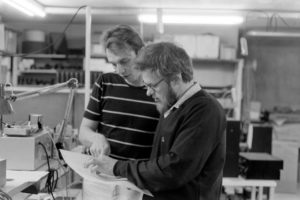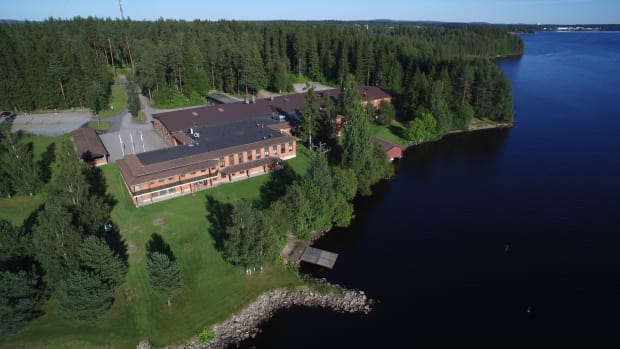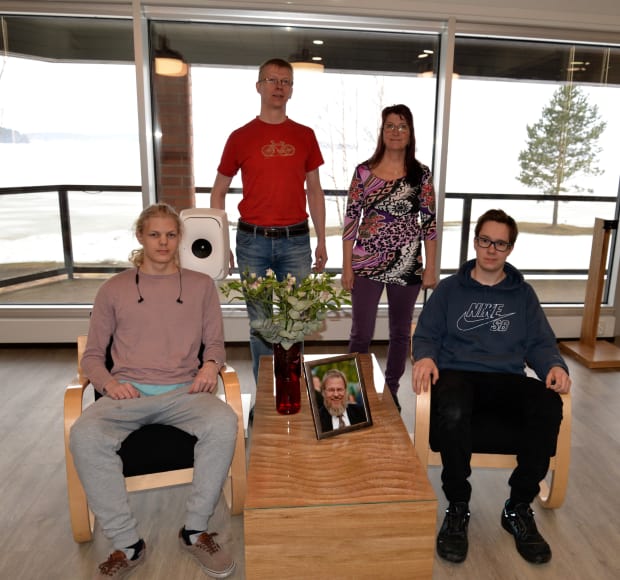
40 years of Genelec: The past, present and future of a pro audio icon
PSNEurope looks back on the brand’s illustrious history and hears from the team taking it into its fifth decade.
Some four decades ago, two childhood friends returned home from Helsinki to a remote village in Finland harbouring dreams of a future building loudspeakers. Now, as Genelec celebrates its 40th year in the business of professional audio, the next generation is at the helm. However, the lessons of the past still remain fresh in their minds, as PSNEurope finds out…
Though Ilpo Martikainen had decided to become an entrepreneur, he had yet to settle on how. The young man from the remote town of Lapinlahti was not to be taken lightly. Earnest, thoughtful and among Finland’s most talented engineers, he had already concluded his studies and moved to Helsinki, taking up the post of managing director for a small engineering firm. The churning politics of the 20th century had delivered a post-war economic boom that could be felt in the streets of the capital. But for Martikainen, the rapid change and quick conversation felt distant from the silent forests and still lakes of his boyhood.
Surrounded by the chatter and bustle of the city, he had sent for his childhood friend, Topi Partanen, with whom he could sit for hours, uttering not a word. They had met at school, when the 15-year-old, electronics-obsessed Partanen had chanced upon a circuit diagram made by the 17-year-old Martikainen, and sought the older boy out. Having recognised one another as kindred spirits, the two embarked on an adolescent campaign of loudspeaker construction.
Years later, in Helsinki, the notion of an entrepreneurial career spent building loudspeakers seemed fanciful, and so the two friends focused instead on earning a living and raising young families, while Martikainen waited patiently for inspiration to strike. They weren’t waiting long.
“We were attending an acoustic seminar in Helsinki,” recalls Partanen, more than four decades later. “There were also some guys from the Finnish broadcasting company, YLE, including Juhani Borenius, the chief acoustician, with whom we were discussing audio and loudspeakers. He told us that they were going to buy new monitors for their headquarters in the city and then, from nowhere, they asked us if we could maybe help them in designing a better monitor.”
The new speakers, they explained, had to adhere to new N12-B regulations, offering a flat frequency response and room response controls. Without a moment’s hesitation, Martikainen seized his opportunity with a decisive “yes”.
As soon as the men from YLE had left the room, Martikainen snapped his attention back to his old confidante and asked: “What’s a monitor?”
The city and the forest
Now celebrating its 40th anniversary, today Genelec stands as one of the professional audio world’s most revered and recognised brands; the company’s four decades of history are filled with contrasts and confounded expectations.
Embedded within the company’s DNA is the belief, dearly held by Martikainen, that a manufacturer could be based in his beloved, frequently snow-covered home of Savo, Finland, yet still export leading products to every major city on the planet.
At first, the idea seemed preposterous – the initial plan to base the company in Lapinlahti had to be abandoned because, in 1978, the village had yet to adopt an automated telephone exchange. But an alternative headquarters was soon found in Iisalmi, in the basement of the building in which the Martikainen family also briefly lived. From there, he swiftly proved his point, as Genelec’s first order went to Italian broadcaster RAI (a huge order from Finland’s YLE followed soon after).

The contrast that was created by that early decision still remains vivid. This month, the great and good of the audio world will assemble in Iisalmi to toast the company’s 40th birthday. To do so they will first fly from their city of origin into Helsinki, then continue with another hour-long flight to the tiny airport of Kuopio, followed by a drive of more than an hour through dense forest. Finally, they will arrive at lake Porovesi, beside which the Genelec factory sits.
Upon entering the reception they will be greeted by a beautiful view over the lake, and a small, framed photograph of the company founder. Martikainen passed away in January 2017, having achieved more than perhaps even he first imagined.
“No matter whether it was active monitors or something else, Ilpo would have become an entrepreneur,” reflects Genelec managing director Siamäk Naghian. “He would have found a different direction, but the end result would have been the same. It’s important to realise that Ilpo didn’t make himself into a rich man or a famous man, in fact he tried keep away from all of the attention. He was actually a very shy person.
“For Ilpo it was about building this company, creating something that was about more than just himself. He did everything for that one goal, it was all for the good of the people around him.”
Stories abound within Genelec of the company founder who always had time for his colleagues.
“It was rare that you found Ilpo in his office, he was always in the factory, in R&D or talking with someone,” explains Sirkka Kopeli, who joined the company 23 years ago and now leads the production of the 8030.
“He created a special atmosphere,” agrees Seija Katainen, a member of the team since 1991. “We were like a small family.”
For others, the chance to work at Genelec was literally life changing.
“In October, I will have worked here for 25 years, I started in 1993,” says Marko Rönkä. “I was in the army but when I came home there was no work. The Soviet Union had collapsed and so had Finland’s economy. Then, one morning, Ilpo’s wife Annikki asked me if I could help with her car battery – we were neighbours. The next day Ilpo called me to ask if I wanted to work at Genelec. After that he would always make time to speak with me. He was like a father to me.”
What began with a handful of dedicated souls, including Partanen, current chairperson of the board Ritva Leinonen and, a little later, the acoustic designer Ari Varla, soon grew to a team of 20, then hundreds more. Traditions arose that still remain an integral part of the company’s ethos, from communal coffee breaks twice a day, to group exercise sessions, workstation massages and the principle that anyone can talk to anyone. “It all came from Ilpo,” adds Kopeli.
Perhaps the most fundamental lesson that still resonates through the company is that of sustainability. “When you visit Iisalmi, you can see where that comes from,” says Naghian. “In this part of the world, they realised very early on that they had to consider the regeneration of the forest, so the idea of sustainability was like mother’s milk to Ilpo – if you take one tree down, you plant another. This has been at the heart of the company from the beginning.”
Once the company outgrew the basement, they worked from the brand new lakeside factory, paid for not only by the sale of monitors, but systems integration work for the Soviet Union.
“A significant revenue stream came courtesy of a contract with the Soviet Union, including a new sound system for the circus building in Moscow,” explains Lars-Olof Janflod, who started selling Genelec products in Sweden in the mid-1980s, officially joined the company in 1992, and has since served in a number of sales and marketing roles, travelling the world several times over to spread word of the brand internationally.
“The early years of the company were quite tough, not least because we were selling active monitors – even at the beginning of the 1990s, when I visited trade shows around the world people would ask me if they could use their own amplifiers! So we needed to look for other avenues of income and in the 1980s there were a lot of opportunities to do systems integration. Another project for the Soviet Union was to design a driver manufacturer plant in Estonia, to provide the Soviets with hi-fi speakers.”
Eventually, the mid-1980s launch of the 1025 was the catalyst for a debate over Genelec’s future.
It was the company’s first large main monitor, and while its audio quality drew praise from all quarters, its SPL capacity was lacking.
“It led to the first Genelec distributor meeting, in 1986,” recalls Janflod, who at the time was working for the Swedish distributor, Intersonic. “It was a great speaker, no question about that, but it was simply not loud enough, so something had to be done. It sparked a debate over what Genelec should be – a systems integrator or a manufacturer of active monitors, and the latter won.”
The systems integration division was sold off and in 1989 a new product emerged in the shape of the 1035A. The monitor rapidly rose to prominence in key markets such as the UK and Japan, solidifying Genelec’s international reputation.
Since then the landmark products have followed in quick succession: the compact but powerful 1031, followed by the 1038, the 8000 series including the coaxial 8260, and most recently the 8331, 8341 and 8351, collectively known as The Ones.
Each model has been improved with technologies such as the Directivity Control Waveguide, the Minimum Diffraction Enclosure, the Laminar Spiral Enclosure for improved low frequency reproduction, and Smart Active Monitoring (SAM™), at the heart of which is Genelec Loudspeaker Manager (GLM) software.
R&D engineer Pekka Moilanen, a Genelec veteran of 27 years, began his career working closely with Ari Varla, and has watched the company grow around him. “One day the time came when I suddenly didn’t know everyone in the factory! That was sort of strange, to see a guy who worked here but I didn’t know his name. But when it comes to passing on the company’s values, I don’t think it’s down to one individual to do that, it’s the responsibility of the collective. It’s up to people like Siamäk and the family to shape the atmosphere in the company, and to us to make sure that we maintain the values and traditions that Ilpo created.”
The new generation
“My mum was seven months pregnant when they moved to Iisalmi,” smiles Maria Martikainen, the third child of Ilpo and his wife Annikki. “Somewhere at home we have a photograph of me and Ari – I’m maybe one-year old, and I’m just sat next to him, on his table, watching whatever he’s doing. Genelec has always been such an integral part of our family that it’s impossible to imagine it not being part of our lives.”
Though Maria and older brothers, Juho and Mikko, are sometimes described as the new generation within Genelec, the three siblings have in fact long been part of the business, having sat on the board since 2001. Juho, the classically trained double bassist, is a brand ambassador within international music circles, while Mikko, the software engineer, works on the company’s administration systems and CRM. Maria, the youngest, now occupies her father’s old office, and has taken up the mantle of his work with the broader Genelec family. These days it’s called HR, but really it’s a matter of tradition – an open door and an open mind.

“Genelec has been like the fourth child in our family, so to think about yourself and your identity without it is impossible. In that sense I think it has always been clear that somehow I would be a part of it,” she reasons.
She adds, however, that her father’s public image was somewhat different to her own impression.
“There was one time, my mother came home from a trip and she found him scrubbing at his shirts, because he hadn’t been able to find the clean ones in the closet! He was a wise man with deep insight… but he couldn’t find his socks.”
Taking a more active role in the company has had something of a transformational effect on how Maria and her brothers view their father’s work and legacy. She first attended an AES convention at the tender age of 15, and found herself confused by the attention that surrounded Ilpo and the company he led.
“In our family, even though Genelec was a huge part of us all, it was never thought of in awe,” she explains. “It was just normal. My father was very humble. We understood that the people who work at Genelec come first. So I actually didn’t know that it was such a big deal… out there.” She waves a hand at some distant place beyond the forest.
Now she understands Ilpo’s legacy, and the part that she and her brothers play in it.
“It is challenging, we have so many new people joining the company and with Father passing away… it can be difficult to maintain our heritage. This is always a challenge in family-owned companies, for the next generation to keep the best parts of the past. But what Ilpo and Topi and all of the others achieved was to keep on growing, keep on developing, and that is what we must also do.
“There is a risk of admiring too much. For the next generation, it’s about combining our heritage with the way that we want to run this company.”
Nor are they alone – throughout the company, a new generation is arriving, from acoustical engineer Juha Holm, who worked beside Ilpo in his final months, ultimately producing The Ones, to Sami Kopeli, son of Sirkka, and Kaapo Moilanen, son of Pekka. Under the leadership of Naghian, they represent the beginning of something old and something new.
“If you consider the generation in which Ilpo and Topi grew up, they were the first to be raised after the pressures of the Second World War, and they felt a responsibility for the development of the country and their society,” says the managing director. “They had a very tough childhood experience, but they also felt the possibility of rebuilding the country in an entirely new way.
“This new generation has a similar passion. They don’t want to be here just to copy something somebody else has done, they want to make things better. From generation to generation, if you lead the company in the right way, you can make a connection.”
Source: mi-pro.co.uk










